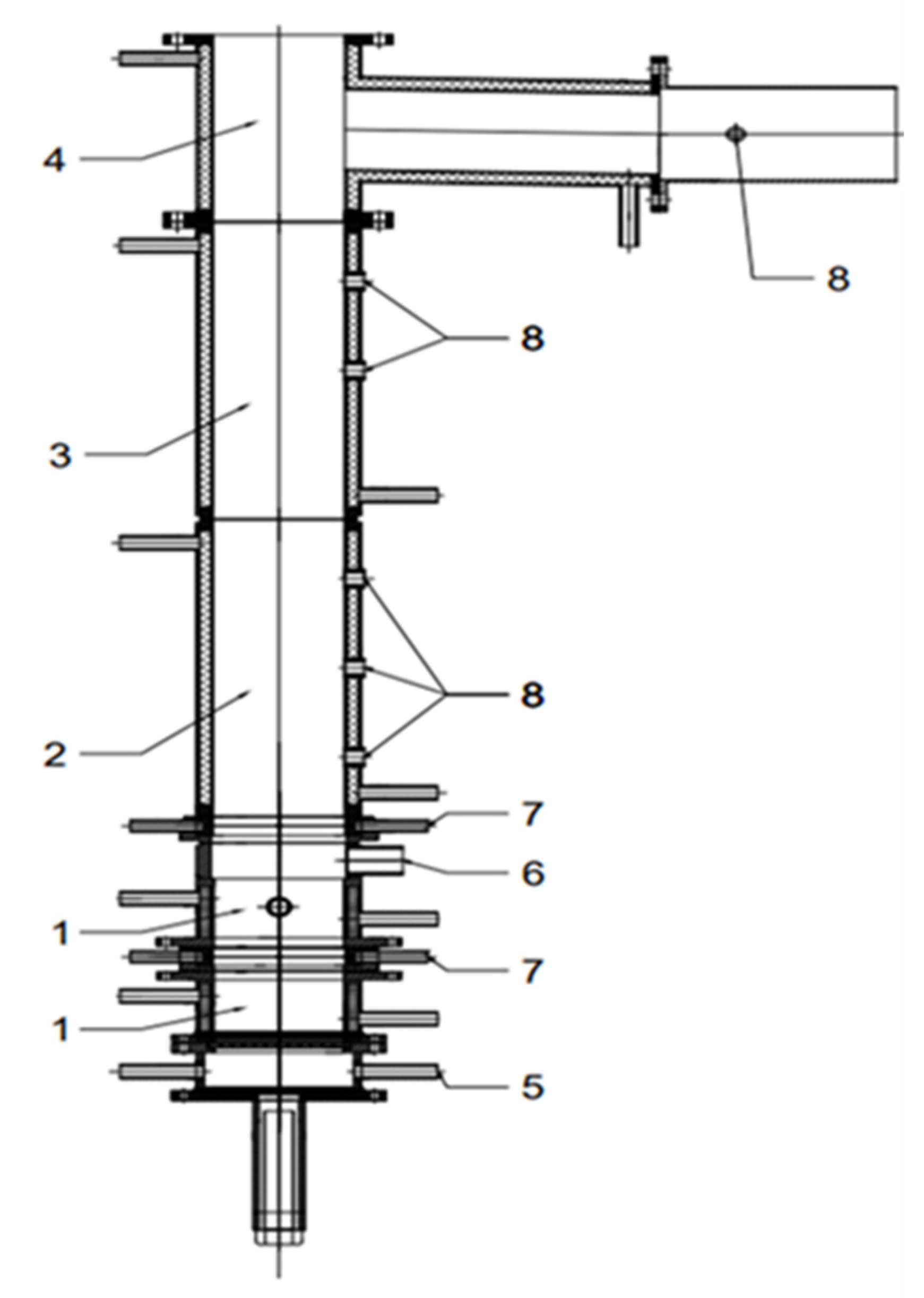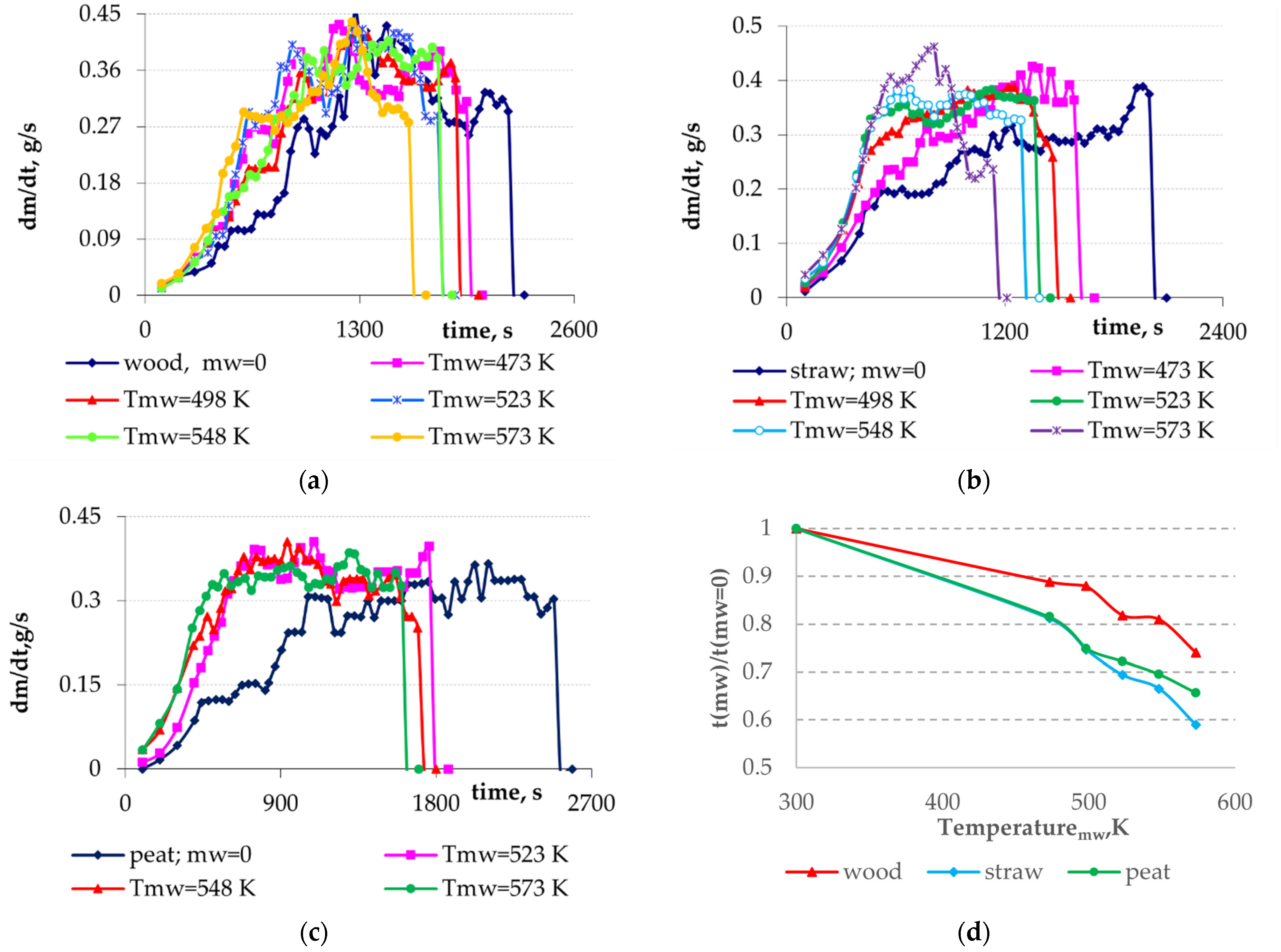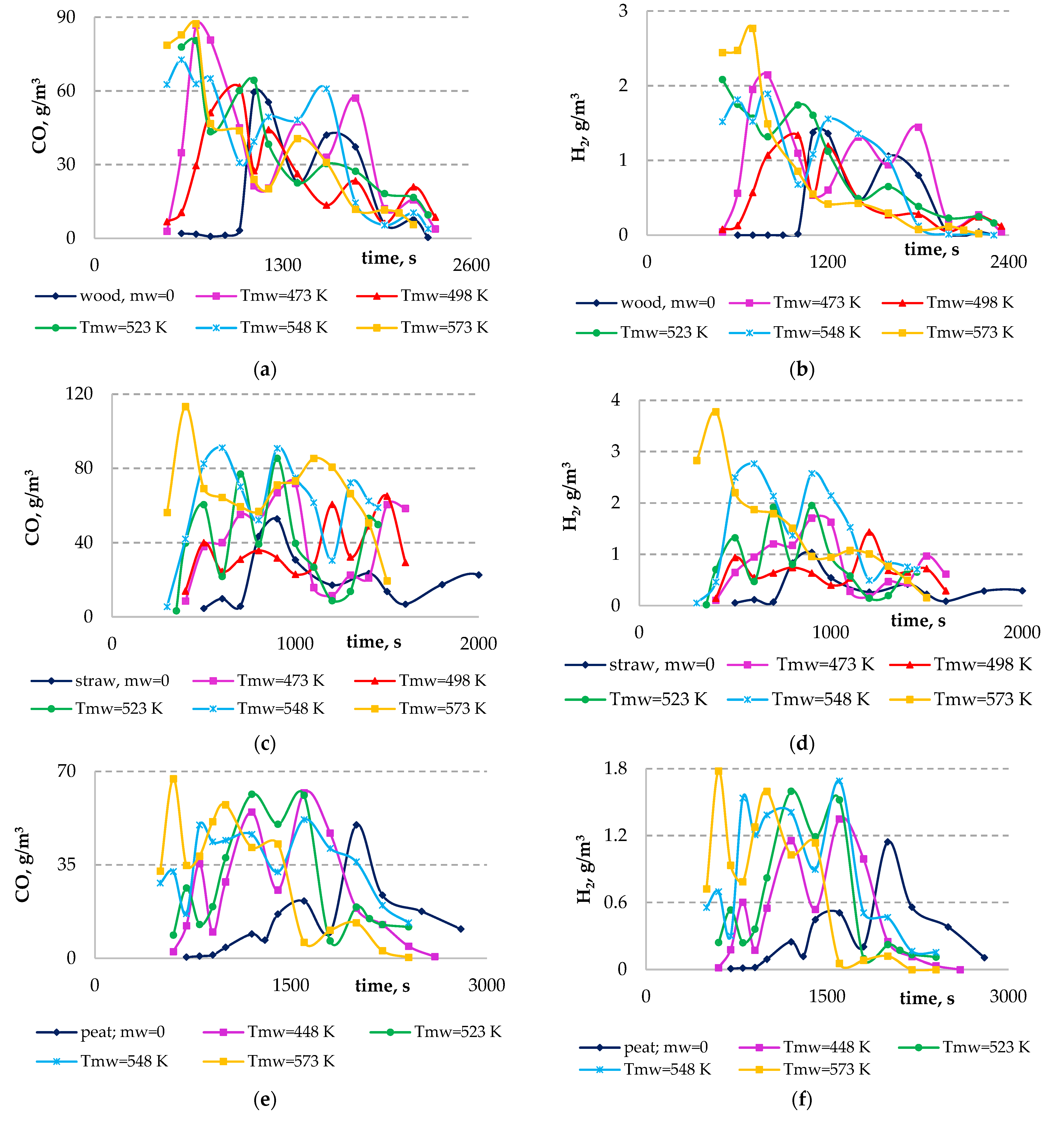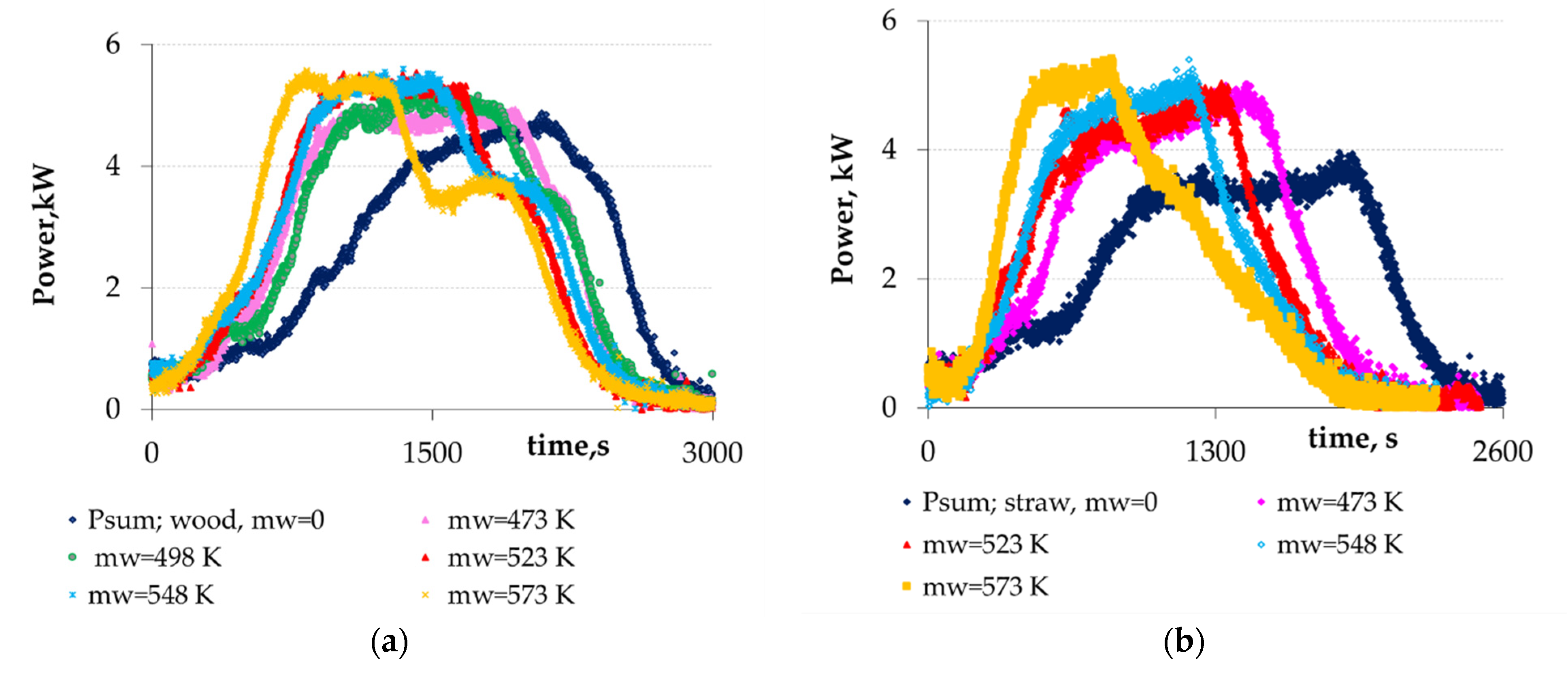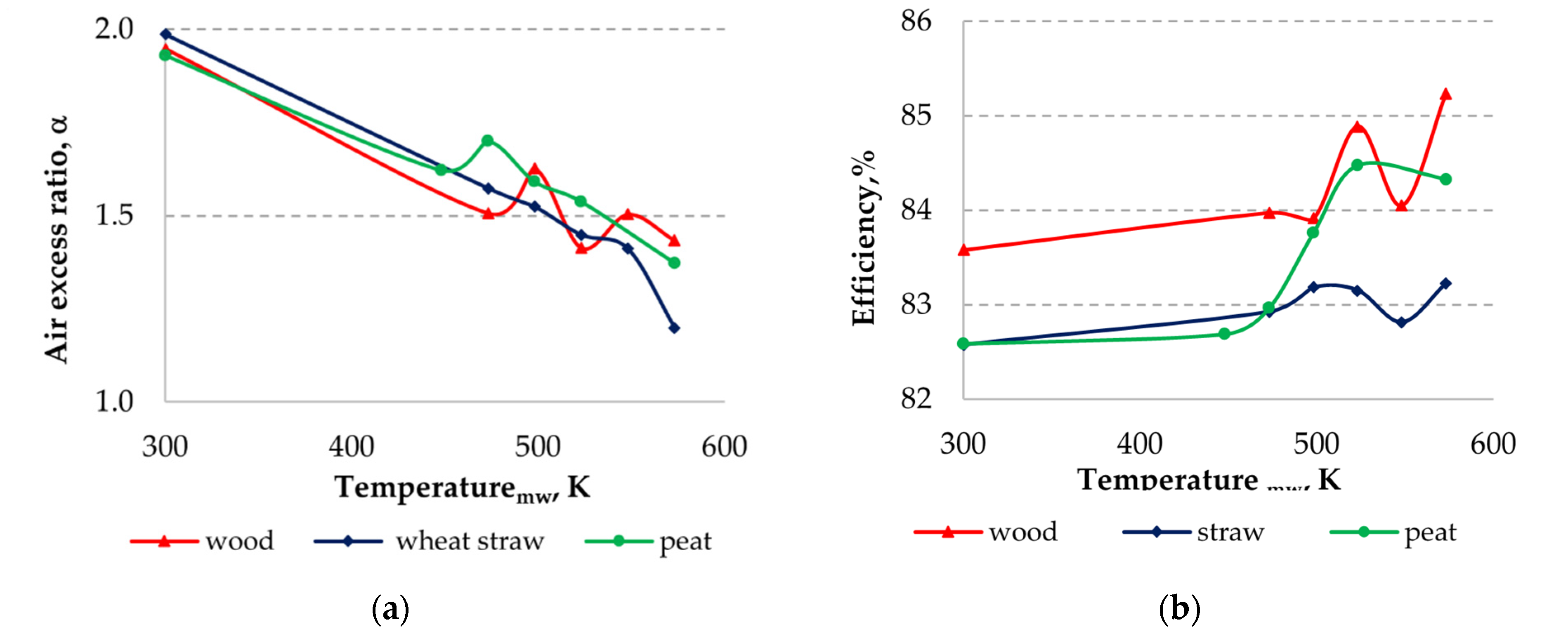3.1. The Effect of MW Pre-Treatment on the Main Characteristics of Lignocellulosic Pellets
The preliminary experimental study of the time-dependent variations of the weight loss of wood, straw and peat pellets showed that, for equal times of mw pretreatment (240 s), when the temperature of pellets nears 480–500 K, the highest weight loss (dm/
m0, %) during the microwave pretreatment was observed for wheat straw pellets (up to 24%), which strongly exceeded the initial moisture content in the raw pellets (10.2%). Relatively less weight loss during microwave pretreatment was observed for wood (12%) and peat (7%) pellets, with the initial moisture content in the pellets being 7.14% for wood and 8.9% for peat. The changes in weight loss of pellets dm/m
0 during their mw pretreatment in the microwave oven can be expressed in the following order: straw > wood > peat. During mw pretreatment of wood, wheat straw and peat pellets in the rotating reactor, the temperature of pellets was increased up to 570 K, determining the enhanced weight loss of pellets. The weight loss of wheat straw pellets was increased up to 53%, but nearly equal weight loss was observed for wood and peat pellets ca. 32%. Because the content of volatiles in straw is about 79.4% [
19], more than half of the straw was converted into gas products. The process of drying was dominant for wood and wheat straw biomass for mw pretreatment at 448–498 K. Negligible transformation of the biomass structure occurred in this temperature range. At temperatures >498 K, the above-mentioned process of chemical structure transformation took place actively for both treated biomasses. For peat, the measurable weight loss due to biomass thermal destruction was observed at a lower temperature range of 448–473 K, which linearly increased with an increase of the processing temperature, in contrast to wheat straw and wood, for which exponential increase in weight loss was dependent on the treatment temperature (
Figure 2).
This suggests that the microwave pretreatment of pellets contributes not only to the release of moisture, but also to the primary decomposition of hemicelluloses, cellulose, and lignin. Analysis of the thermal decomposition of lignocellulosic biomass has shown that the exothermic thermal decomposition of hemicelluloses, with apparent changes in its structure, occurs at
T ≈ 490–590 K; endothermic thermal decomposition of cellulose, with breakdown of glycosidic structure and loss of crystallinity, starts to develop at
T ≈ 590–670 K; the decomposition of lignin occurs at temperatures between 430–1100 K [
6,
20].
Hemicelluloses decompose easily, while the lignin is most difficult to decompose but is most available for development of inter-condensation processes, carrying out the highest increment into the formation of char residue [
20,
21]. Hence, by increasing the pretreatment temperature of pellets above 470 K, the mw irradiation of pellets starts with the primary endothermic decomposition of polymer-like hemicelluloses, responsible for higher CO
2 yield in results of decarboxylation reaction, and is followed by endothermic decomposition of celluloses, which is responsible for the high yield of chemically bonded H
2O, CO and CO
2. Along with such products as methanol and acetic and formic acid, anhydrosygars were formed as a result of the thermal degradation of the carbohydrate complex of biomass in the temperature range under study [
22]. The decomposition of lignin produced higher yields of H
2 and CH
4. Simultaneously, the condensation of major biomass components took place also with the formation of novel C=C bonds [
22]. The contribution of condensation processes of biomass components in charcoal formation was decreased in the range: lignin > cellulose > hemicellulose [
21]. The enhanced yield of gas products promoted variations in the surface structure, increasing the porosity of pellets (
Table 1).
The variations of the surface structure and porosity of pellets promoted an increase in their reactivity, which is defined in terms of the conversion rate per remaining mass (1/
mt* dm/dt) [
23] and can be expressed as follows:
where
, is the mass of the biomass substrate at the beginning of reaction or initial time,
is the mass of the biomass substrate at any time,
t, and
is the mass of the biomass at the end of the reaction time.
where
α is the degree of conversion of pellets at time,
t;
A,
E and
R are the frequency factor, activation energy and gas constant, respectively;
n is order of reaction according to the assumed reaction model.
The partial decomposition of the main constituents of lignocellulosic biomass with the enhanced yield of gas products during mw pretreatment of pellets promotes not only the structural changes of pellets, but also causes variation in their elemental composition and heating values, which are presented in
Figure 3a–f, normalized to main characteristics of raw pellets for
T = 300 K.
As follows from
Figure 3, increasing the temperature of mw pretreatment above 470 K correlated with an increase of the carbon content in the pretreated pellets, while a decrease of the hydrogen and oxygen contents dominated. In addition, for straw and peat pellets, the nitrogen content in pellets tended to increase, while it tended to decrease with the mw pretreatment of wood pellets. This suggests that the different chemical composition of pretreated biomass pellets is responsible for the different yield of gas products (H
2, CO, CO
2, CH
4, NO
x) during the microwave pretreatment of pellets. Hence, a decrease of H
2 content in pellets after mw pretreatment can be related to the enhanced yield of H
2 and CH
4 due to cracking and deformation of lignin with a higher content of aromatic ring and O–CH
3 functional groups [
20]. Thermal decomposition of cellulose due to a higher carbonyl content results in the highest CO yield during mw pretreatment of pellets, while the thermal decomposition of hemicellulose with higher carboxyl content results in the highest CO
2 yield [
20].
It was shown that the yields of non-condensable fractions consisted predominantly of CO, CO
2, CH
4; H
2 was increased with increasing mw pretreatment temperatures for all biomass under study (
Figure 4a–d).
The highest weight loss and the highest yield of non-condensable gases in degradation products were established in the case of wheat straw that was mw pretreated at 570 K, which can be explained by the highest portion of thermolabile hemicellulose in its composition as well as an amorphous structure of cellulose in comparison to that ordered in wood biomass composition. In this case the portion of non-condensable gases in degradation products of peat was the highest over the entire range of pretreatment temperatures. This can be explained by the fact that, unlike wood and wheat straw, peat consists of degraded plant vegetation. As a result of the long-term microbiological and pyrolytic influences in anaerobic conditions, deep degradation/transformation of the plant cell wall components takes place, with the formation of humic compounds; these are high molecular heterogenic compounds with complicated structures whose properties and structure differ greatly from their precursors, including polyphenolics, carbohydrates, proteins, etc. [
24].
For all samples under study, water was the dominant component of condensable fraction removed from biomass by mw pretreatment, resulting in not only physical water elimination but also dehydration reactions of carbohydrates and condensation reactions within lignin and cellulose substituents. This is the reason for a significant decrease of a relative portion of oxygen in pretreated biomass. With an increase in the torrefaction temperature from 470 K up to 570 K, the water content in the collected condensates decreased from about 99% (for all biomass samples under study) to 68%, 87% and 86% for wheat straw, wood, and peat, respectively. This indicates that, with an increase of the mw pretreatment temperature, comparatively high molecular fragments of biomass components become volatile, thus modifying the structural and elemental composition of pretreated biomass. The portion of these compounds is the biggest in the case of wheat straw, indicating its higher thermolability in relation to wood and peat.
The enhanced yield of H
2O, CO
2 and CH
4 during mw pretreatment is responsible for the enhanced decrease of oxygen and hydrogen content in pretreated pellets when compared with relative changes to the carbon content in pretreated pellets, which tends to increase, resulting in an elevated HHV of carbonized residue (
Figure 3a,f). The HHV of untreated pellets was 19.94 MJ/kg for wood, 18.41 MJ/kg for straw and 20.86 MJ/kg for peat. The highest increase of the HHV after mw pretreatment of pellets was for wheat straw (41%), with the highest increase of the carbon content, while there was a decrease in the oxygen and hydrogen content in pretreated pellets (
Figure 3b,c). A relatively smaller increase of HHV was seen for wood (22%) and peat (28%), with a smaller decrease of hydrogen and oxygen content after mw pretreatment of pellets and a smaller increase in the relative carbon content in pretreated pellets.
The mw pretreatment of pellets also promoted the variation in relative ash content in biomass, determining a relatively higher increase of the ash content in wheat straw pellets, while a relatively smaller increase was seen for wood and peat (
Figure 3e), which is the main negative effect of mw pre-processing of pellets.
3.2. The Effect of MW Pre-Treatment on the Main Characteristics of Lignocellulosic Pellets
From the data summarized in
Table 1, it can be concluded that increasing the temperature of mw pretreatment results in a partial thermal degradation of the main constituents of lignocellulosic biomass pellets (hemicelluloses, cellulose and lignin), enhancing the yield of volatiles, the total pore volume and the surface area of the pellets, which are key factors for increasing the reactivity of pretreated pellets, determining faster and more efficient thermal decomposition of pretreated pellets during their gasification. This is confirmed by the kinetic study of the weight loss of the pretreated pellets (
Figure 5a–c) and the yield of gas products (CO
2, H
2, CO, C
xH
y) during their gasification (
Figure 6a–d); increasing of the temperature of mw pretreatment correlated with a faster weight loss rate and the yield of gas products, decreasing the relative duration of the thermal decomposition normalized to those for raw, non-treated pellets (mw = 0 in plots) (
Figure 5d).
Under equal temperatures of the mw pretreatment (573 K) the total pore volume and the surface area of the pretreated wheat straw pellets was larger than that for pretreated wood or peat pellets (
Table 1). As a result, the higher reactivity of the mw pretreated wheat straw pellets caused more a pronounced decrease of the duration of the pretreated wheat straw thermal decomposition (by about 40%) when compared with the thermal decomposition of the pretreated wood or peat pellets (by about 27–30%). In addition, the higher reactivity of the wheat straw pellets correlated with the enhanced yield of volatiles (CO, H
2) during the gasification of the pretreated wheat straw pellets, increasing the peak value of the yield of CO from 31.8 g/cm
3 for the raw pellets up to 113 g/cm
3 for the pellets pretreated at 573 K. Correspondingly, the yield of H
2 increased from 0.4 g/cm
3 up to 3.8 g/cm
3. As follows from
Figure 6a–f, increasing the temperature of mw pretreatment of pellets also enhanced the formation of secondary peaks of the yield of combustible volatiles (CO, H
2) during the end stage of the thermochemical conversion of pretreated pellets
t > 1000s, which correlated with a slight increase of the weight loss of pellets (
Figure 5a–c).
Increasing the temperature of mw pretreatment also influenced the average values of the yield of H
2, CO and CO
2 during their thermal decomposition, increasing average values of the yield of CO, H
2, CO
2 and the weight loss of pellets up to maximum values. The maximum value of the yield of CO
2 was fixed at the lower temperatures of mw pretreatment of lignocellulosic pellets (
T ≈ 470–500 K), while the yields of CO and H
2 tended to increase when increasing the pretreatment temperature up to
T ≈ 548–573 K (
Figure 7a–c).
Considering the effect of mw pretreatment of lignocellulosic pellets on the yields of volatiles, it should be noted that there are several factors that can cause changes in the average yield of energy enriched volatiles during thermal decomposition of pellets if the pretreatment temperature of the pellets is increased. As was shown, the mw treatment promoted simultaneously the degradation and secondary condensation reactions of major biomass components by removing from volatiles a portion of water that varied in the range of 68–99%. The yield of volatiles was increased with increasing of mw treatment temperature (
Figure 4). Therefore, the relative portion of water in products of pretreated biomass gasification was decreased, thus increasing the content of energy-enriched volatiles. In addition, the enhanced yield of volatiles could be related to the partial thermal destruction of hemicellulose, cellulose and lignin; as the temperature of mw pretreatment was raised, the enhanced porosity and reactivity of pellets (
Table 1) elevated the yield of volatiles and the weight loss of pellets during the thermal decomposition of pretreated pellets (
Figure 5 and
Figure 6). Next, as follows from
Figure 3a, increasing the temperature of mw pretreatment could cause carbonization of lignocellulosic pellets. Correspondingly, as follows from
Figure 6a–f and
Figure 7a–c, the enhanced carbonization of pellets, caused by increasing the mw pretreatment temperature, could produce considerable variations in the yield of CO and CO
2 during the thermal decomposition of pretreated pellets, which for the limited sub-stoichiometric primary air supply in the device, could be attributed to the development of the exothermic partial oxidation of carbonized pellets (3) and competitive development of endothermic Boudouard’s reaction (4), increasing the yield of CO, while gradually decreasing the yield of CO
2 [
19]:
In addition, the higher yields of CO and H
2 during thermal decomposition of carbonized pellets can be produced due to the development of the endothermic water-gas reaction:
As a result of the competing processes developed during thermal decomposition of pretreated pellets, increasing the pretreatment temperature significantly affected the thermal decomposition of activated pellets and the formation of volatile compounds, causing a rapid increase in the yield of CO and H
2 when the mw pretreatment temperature of pellets was increased above 470–500 K (
Figure 7). However, the yield of CO
2 increased to its maximum value with a subsequent decrease if the pretreatment temperature exceeded 470–500 K (
Figure 7a–c). A particularly pronounced decrease in the yield of CO
2 during thermal decomposition of pretreated pellets with a subsequent increase of the yield of CO and H
2 was observed for pretreated straw and peat pellets for which an increase in mw pretreatment temperature provided a more rapid increase in the carbon content of pretreated pellets (
Figure 3a).
3.3. The Effect of MW Pre-Treatment of Lignocellulosic Pellets on the Combustion Characteristics
The formation of the combustion zone for the given configuration of the pilot device (
Figure 1) was determined by mixing of the axial flow of combustible volatiles (CO, H
2) with the secondary swirling air, which was fed to the base of the combustor. The ignition and combustion of volatiles resulted in the formation of the reaction zone, with a marked increase in temperature and axial velocity up to their peak values, which were observed close to the flame axis, where the average flame temperature tended to increase to 1000–1200 K, whereas the axial and tangential velocities increased to 1.3–1.4 m/s. Microwave pretreatment of lignocellulosic pellets, with the enhanced weight loss in pellets and the yield of volatiles during the thermal decomposition of pretreated pellets, significantly affected the combustion conditions at the flame base, gradually decreasing the air excess ratio at the flame base from
α ≈ 1.2–1.35 during thermochemical conversion of raw pellets to
α ≈ 0.97–1.17, increasing the temperature of mw pretreatment and thus improving the main combustion characteristics. In addition, the variations in the surface area, porosity and elemental composition of pellets contributed to faster ignition and burnout of volatiles. This was confirmed by measurements of the flame temperature and heat output kinetics for the different pretreatment temperatures of the pellets. Kinetic study of the flame temperature showed that increasing the temperature of mw pretreatment resulted in the faster ignition of volatiles, faster formation of flaming combustion and faster transition to after-flame smoldering stage, decreasing the duration of the burnout of pretreated pellets (
Figure 8a–c). Kinetic study of the flame temperature and the weight loss of pellets for the different temperatures of mw pretreatment confirmed that the decrease in the duration of the burnout of the pretreated pellets correlated with the decrease in the duration of their thermal decomposition and the weight loss of pretreated pellets (
Figure 5d). In addition, the most pronounced decrease in the duration of the burnout by increasing the temperature of mw pretreatment was observed for wheat straw pellets (
Figure 8d), which had the largest increase in the weight loss of pellets, the yield of volatiles, surface area and porosity during the mw pretreatment (
Table 1), thus promoting an increase in their reactivity, as it follows from the kinetic study of the weight loss rates (
Figure 5a–d) and the flame temperature (
Figure 8a–d).
It should be noted that the increase of the temperature of mw pretreatment also affected the average value of the flame temperature (
Figure 8e), which could be related to variations in the yield of volatiles during the thermal decomposition of pretreated pellets. Thus, the new balance between the competitive processes of the enhanced thermal decomposition of the main constituents (hemicellulose, cellulose and lignin) in lignocellulosic pellets after mw pretreatment promoted the ignition and burnout of combustible volatiles (CO, H
2) and the development of surface reactions (3)–(5). Increasing the pretreatment temperature of pellets correlated with an increase of the flame temperature up to the maximum value, which tended to decrease under the conditions when carbonization of the pellets enhanced the development of endothermic reactions (4) and (5).
The variations of the mw pretreatment regime substantially affected not only the thermal decomposition of lignocellulosic pellets and the flame temperature but also the heat capacity and produced heat energy per mass of burned pellets. By analogy with the effect of the pretreatment temperature on the kinetics of the weight loss of pellets and the flame temperature, increasing the pretreatment temperature of pellets provided faster and more intensive heat release, decreasing its duration (
Figure 9a–c).
The time-dependent variations of produced heat energy for different regimes of mw pretreatment confirmed that the burnout of pretreated pellets was developing as a two-stage process, with a primary stage of flaming combustion of volatiles and the subsequent stage of the burnout of carbonized pellets. In addition, increasing the temperature of mw pretreatment decreased the duration of the flaming combustion but increased the duration of the burnout of carbonized pellets (
Figure 9a–c). Comparing the effect of mw pretreatment on the main characteristics of pretreated pellets (
Figure 3a–f) and produced heat energy (
Figure 9d), it can be concluded that the increase in the produced heat energy per mass of pretreated pellets can be related to the increase in calorific value of pretreated pellets.
3.4. The Effect of MW Pre-Treatment of Lignocellulosic Pellets on the Combustion Efficiency and Composition of the Products
Considering the effect of mw pretreatment of lignocellulosic pellets on their thermal decomposition, flame temperature and heat capacity, it can be concluded that mw pretreatment of pellets can produce variations in the product’s composition and combustion efficiency. Kinetic study of the formation of the main product—CO
2—confirms that, by analogy with kinetics of the temperature and heat output from the device, mw pretreatment of pellets, by producing an increase of porosity and reactivity of pellets, enhances the formation of CO
2 downstream the flame reaction zone, completing the burnout of volatiles and correlating to an increase of the peak and average values of the volume fraction of CO
2 in the products (
Figure 10a).
In addition, the higher weight loss of wheat straw pellets during their mw pretreatment, increasing the surface area, porosity and reactivity of pellets, resulted in a faster and more complete burnout of volatiles, with faster transition from flaming combustion to the surface reactions (3)–(5) and a pronounced decrease of the volume fraction of CO
2 emissions. At the same time, if the temperature of mw pretreatment was raised, an increase of the mass fraction of CO and H
2 in the products (
Figure 10c,d) confirmed the development of endothermic surface reactions (4) and (5). For the pellets pretreated at a higher temperature, the enhanced burnout of volatiles correlated with a decrease of the air excess ratio in the products (
Figure 11a), increasing combustion efficiency (
Figure 11b). In addition, as follows from
Figure 11c, increasing the temperature of mw pretreatment resulted in a decrease of the NO
x emissions in the products, which could be related to the decrease of the flame temperature (
Figure 8e), when carbonization of pellets contributes to the development of endothermic surface reactions (4) and (5) (
Figure 11c).
